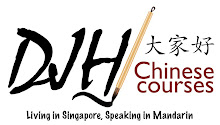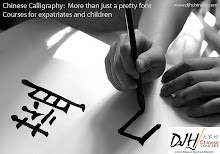
Day 2 of the Mandarin Summer Camp began with a brief lesson in the hotel and off we went to start the day's activity. First of all, we took a bus from the hotel to Orchard MRT station. Here we have Richmond, Clint and EJ at the upper deck of the bus.

Inside the MRT station, we found our courtesy lion wearing a huge mask, telling people to be more aware of H1N1 Swine flu. " Wear a mask if you are coughing or have a cold. Please see a doctor and rest at home too."

After turning a few corners in China Town, we finally found the Red Star Restaurant which is strangely located in a HDB building among old HDB flats. Blk 54 Chin Swee Road level 7.

Red Star Restaurant is a Hong Kong style Dim Sum restaurant. Dim Sums are placed in trolleys as they are rolled out of the kitchen in to the dining place. Some of these trolleys are equipped with steamers to keep the food warm. They go around, in between tables and whenever a customer wishes to have certain dish, it will be served from the trolleys. A stamp will be given on a card to indicate a dish is being ordered.
 The first two dishes were pork's rib (排骨pai2 gu3) and chicken feet (凤抓 feng4 zhua3). The chicken feet dish seems difficult to be accepted by foreigners. It must be a psychological thing.
The first two dishes were pork's rib (排骨pai2 gu3) and chicken feet (凤抓 feng4 zhua3). The chicken feet dish seems difficult to be accepted by foreigners. It must be a psychological thing.


 These are teacups given to us in a tray of hot water. This is for the customers to wash the cups themselves. It is not that the cups served are unwashed. It is just that some people are not very confident about how clean the cups are, and hence some Dim Sum restaurants will have this "wash your own cups" policy to give the customer a peace of the mind.
These are teacups given to us in a tray of hot water. This is for the customers to wash the cups themselves. It is not that the cups served are unwashed. It is just that some people are not very confident about how clean the cups are, and hence some Dim Sum restaurants will have this "wash your own cups" policy to give the customer a peace of the mind. Clint happens to be a vegetarian. The vegetarian fried rice is very nice.
Clint happens to be a vegetarian. The vegetarian fried rice is very nice.




 After our Dim Sum meal, we found some durians, something new to foreigners and locals call it the King of Fruits.
After our Dim Sum meal, we found some durians, something new to foreigners and locals call it the King of Fruits. We were not courageous enough to try durians, hence we tried pineapple instead, a tropical fruit that Richmond and EJ had never tried before.
We were not courageous enough to try durians, hence we tried pineapple instead, a tropical fruit that Richmond and EJ had never tried before.
 After having a taste of tropical fruits, we went to visit Yu Hua Guo Huo to check out some Chinese products.
After having a taste of tropical fruits, we went to visit Yu Hua Guo Huo to check out some Chinese products. Emery and EJ were examining a jar of bird’s nest. Bird’s nest in this case is not made of leaves and twigs but are actually bird's saliva or "bird's spit". The swallows use their saliva in building their nests. Then, people harvest these nests and process them. Bird’s nest is known to be good for the skin and health.
Emery and EJ were examining a jar of bird’s nest. Bird’s nest in this case is not made of leaves and twigs but are actually bird's saliva or "bird's spit". The swallows use their saliva in building their nests. Then, people harvest these nests and process them. Bird’s nest is known to be good for the skin and health.Read up more on bird's nest soup.

 Tiger Balm (traditional Chinese: 虎標萬金油; pinyin: hǔbiao wànjīnyóu) is the trade name for a heat rub manufactured and distributed by Haw Par Healthcare in Singapore. It was originally developed in the 1870s by a herbalist, Aw Chu Kin, in Rangoon, Burma, who asked his sons Aw Boon Haw and Aw Boon Par on his deathbed to perfect the product.
Tiger Balm (traditional Chinese: 虎標萬金油; pinyin: hǔbiao wànjīnyóu) is the trade name for a heat rub manufactured and distributed by Haw Par Healthcare in Singapore. It was originally developed in the 1870s by a herbalist, Aw Chu Kin, in Rangoon, Burma, who asked his sons Aw Boon Haw and Aw Boon Par on his deathbed to perfect the product.* Tiger Balm Red - for muscular aches and pains.
* Tiger Balm White - for same functions stated above, at a weaker dose for a less intense "warming feeling."
http://en.wikipedia.org/wiki/Tiger_balm

 A huge tea pot. 一个很大的茶壶。
A huge tea pot. 一个很大的茶壶。 Tea-leaves were traditionally packed into circular discs and blocks for easy transportation. Tea formed part of the important trade between China and the rest of the world in the olden days.
Tea-leaves were traditionally packed into circular discs and blocks for easy transportation. Tea formed part of the important trade between China and the rest of the world in the olden days. 牛车水 (niu2 che1 shui3) is the name of Singapore's China Town. In most places in the rest of the world, China Town is called 唐人街 (tang2 ren2 jie1), a literal translation. However, the MRT station for China Town has retained its original name as 牛车水(niu2 che1 shui3). This is to preserve the uniqueness of our China Town in Singapore.
牛车水 (niu2 che1 shui3) is the name of Singapore's China Town. In most places in the rest of the world, China Town is called 唐人街 (tang2 ren2 jie1), a literal translation. However, the MRT station for China Town has retained its original name as 牛车水(niu2 che1 shui3). This is to preserve the uniqueness of our China Town in Singapore.牛车水, these three words mean ox, cart and water. This is because in the olden days, water was being sold there using ox cart hence giving the place the name. The place was also being allocated by the British as a place where the Chinese lived.
 In the MRT to Bugis.
In the MRT to Bugis. We discovered an interesting antique shop in Bugis.
We discovered an interesting antique shop in Bugis. Sultan Mosque
Sultan Mosque
 We need to remove our shoes before entering the mosque.
We need to remove our shoes before entering the mosque. Clint was given this robe in the mosque as he was wearing shorts which is not too appropriate. Same for EJ.
Clint was given this robe in the mosque as he was wearing shorts which is not too appropriate. Same for EJ.






 A vintage toy museum.
A vintage toy museum. These are wooden molds used to make moon-cake during the Moon-cake Festival sometime in September.
These are wooden molds used to make moon-cake during the Moon-cake Festival sometime in September. Clint was trying on this traditional musical instrument 乐器 from Indonesia.
Clint was trying on this traditional musical instrument 乐器 from Indonesia. Coming out from Sultan Mosque, we walked along Arab Street. It got its name probably in the olden day, Arabic merchants were having trades here and gathered around this area. Today, both sides of the road are lined with shops selling fabrics, as well as traditional Malay and Indian costumes.
Coming out from Sultan Mosque, we walked along Arab Street. It got its name probably in the olden day, Arabic merchants were having trades here and gathered around this area. Today, both sides of the road are lined with shops selling fabrics, as well as traditional Malay and Indian costumes.
 The weather was pretty hot as always in Singapore. After walking through Arab Street, we quickly went into Bugis Junction to enjoy some air-con and ice-cream before we headed back to the hotel.
The weather was pretty hot as always in Singapore. After walking through Arab Street, we quickly went into Bugis Junction to enjoy some air-con and ice-cream before we headed back to the hotel.Next week, we will be having a Chinese Heritage Tour to visit places that our forefather from China had left their foot prints. Stay Tuned...













No comments:
Post a Comment